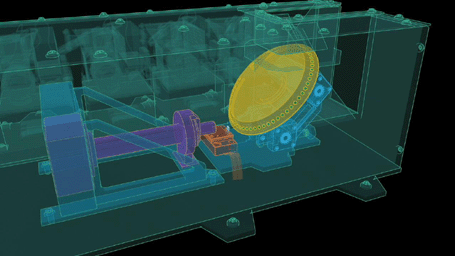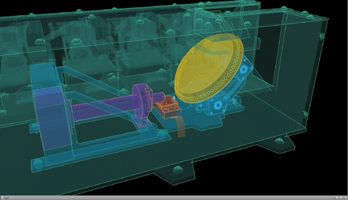
|
Atomic Force Microscope Operation
- Click the image above for a larger view
 Movie Download Options
Movie Download Options- Full-Res JPEG (1279 x 720) (80.8 kB)
- Full-Res TIFF (1279 x 720) (2.8 MB)
Caption:

Click on image for animation (large file)
This animation is a scientific illustration of the operation of NASA's Phoenix Mars Lander's Atomic Force Microscope, or AFM. The AFM is part of Phoenix's Microscopy, Electrochemistry, and Conductivity Analyzer, or MECA.
The AFM is used to image the smallest Martian particles using a very sharp tip at the end of one of eight beams.
The beam of the AFM is set into vibration and brought up to the surface of a micromachined silicon substrate. The substrate has etched in it a series of pits, 5 micrometers deep, designed to hold the Martian dust particles.
The microscope then maps the shape of particles in three dimensions by scanning them with the tip.
At the end of the animation is a 3D representation of the AFM image of a particle that was part of a sample informally called "Sorceress." The sample was delivered to the AFM on the 38th Martian day, or sol, of the mission (July 2, 2008).
The image shows four round pits, only 5 microns in depth, that were micromachined into the silicon substrate.
A Martian particle —only one micrometer, or one millionth of a meter, across —is held in the upper left pit.
The rounded particle —shown at the highest magnification ever seen from another world —is a particle of the dust that cloaks Mars. Such dust particles color the Martian sky pink, feed storms that regularly envelop the planet and produce Mars' distinctive red soil.
Background Info:
The AFM was developed by a Swiss-led consortium, with Imperial College London producing the silicon substrate that holds sampled particles.
The Phoenix Mission is led by the University of Arizona, Tucson, on behalf of NASA. Project management of the mission is by NASA's Jet Propulsion Laboratory, Pasadena, Calif. Spacecraft development is by Lockheed Martin Space Systems, Denver.
Photojournal Note: As planned, the Phoenix lander, which landed May 25, 2008 23:53 UTC, ended communications in November 2008, about six months after landing, when its solar panels ceased operating in the dark Martian winter.
Cataloging Keywords:
| Name | Value | Additional Values |
|---|---|---|
| Target | Mars | |
| System | ||
| Target Type | Planet | |
| Mission | Phoenix | |
| Instrument Host | Phoenix Lander | Phoenix Mars Lander |
| Host Type | Lander | |
| Instrument | Microscopy, Electrochemistry, and Conductivity Analyzer (MECA) | |
| Detector | ||
| Extra Keywords | Atmosphere, Color, Dust, Movie, Storm | |
| Acquisition Date | ||
| Release Date | 2008-08-14 | |
| Date in Caption | 2008-07-02 | |
| Image Credit | NASA/JPL-Caltech/University of Arizona/University of Neuchatel/Imperial College London | |
| Source | photojournal.jpl.nasa.gov/catalog/PIA11040 | |
| Identifier | PIA11040 | |
